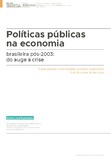Mostrar el registro sencillo del ítem
Políticas públicas na economia brasileira pós-2003: do auge à crise
| dc.rights.license | http://creativecommons.org/licenses/by-nc-sa/3.0/ve/ | es_VE |
| dc.contributor.author | Espíndola, Carlos José | |
| dc.date.accessioned | 2019-08-07T19:11:02Z | |
| dc.date.available | 2019-08-07T19:11:02Z | |
| dc.date.issued | 2019-08-07 | |
| dc.identifier.issn | 1012-1617 | es_VE |
| dc.identifier.uri | http://www.saber.ula.ve/handle/123456789/46066 | |
| dc.description.abstract | A economia brasileira apresentou, no período pós-2003, dois momentos distintos. Um deles, entre 2003-2011, em que os indicadores macroeconômicos se mostraram positivos, constituindo-se como um ciclo de crescimento, e outro, pós-2011, caracterizado pelo baixo desempenho dos mesmos indicadores. Se entre 2004 e 2010, o Produto Interno Bruto (PIB) da economia brasileira cresceu de 5,8 % para 7,5 %, entre 2011 e 2015, declinou de 3,9 % para -3,8 %. Assim sendo, este texto tem como objetivo desvendar quais foram as principais políticas públicas, pós-2003, que influenciaram no dinamismo e na crise econômica brasileira. A conclusão geral é que a fase expansiva (2003-2011) e a fase recessiva (2011-2016) foram frutos da combinação de diferentes fatores internos e externos. Para análise dos fatos, recorreu-se à revisão bibliográfica e à coleta de dados, nos relatórios do Banco Central, do BNDES, entre outras instituições, a fim de apresentar um cenário da economia brasileira pós-2003. | es_VE |
| dc.language.iso | other | es_VE |
| dc.publisher | SaberULA | es_VE |
| dc.rights | info:eu-repo/semantics/openAccess | es_VE |
| dc.subject | políticas públicas | es_VE |
| dc.subject | economia brasileira | es_VE |
| dc.subject | economia mundial | es_VE |
| dc.subject | ciclo de crescimento | es_VE |
| dc.subject | crise econômica | es_VE |
| dc.title | Políticas públicas na economia brasileira pós-2003: do auge à crise | es_VE |
| dc.title.alternative | Public policies in the Brazilian economy post-2003: from the peak to the crisis | es_VE |
| dc.type | info:eu-repo/semantics/article | es_VE |
| dcterms.dateAccepted | junio, 2018 | es_VE |
| dcterms.dateSubmitted | diciembre, 2017 | es_VE |
| dc.description.abstract1 | The Brazilian economy presented, in the post - 2003 period, two distinct moments. One of them, between 2003 and 2011, where the macroeconomic indicators were positive, constituting one cycle of growth, and another, post-2011, characterized by the low performance of the same indicators. If between 2004 and 2010, the Gross Domestic Product (GDP) of the Brazilian economy grew from 5.8% to 7.5% between 2011 and 2015, it declined from 3.9% to -3.8%. Therefore, this text aims to unveil what were the main public policies, post-2003, that influenced the dynamism and the Brazilian economic crisis. The general conclusion is that the expansionary phase (2003-2011) and the recessive phase (2011-2016) were the result of a combination of different internal and external factors. For the analysis of the facts, bibliographic review and data collection were used, in the reports of the Central Bank, BNDES, among other institutions, in order to present a scenario of the Brazilian economy after 2003. | es_VE |
| dc.description.colacion | 154-170 | es_VE |
| dc.description.email | carlos.espindola@ufsc.br | es_VE |
| dc.description.frecuencia | Semestral | es |
| dc.identifier.depositolegal | pp 195902ME658 | es |
| dc.identifier.edepositolegal | ppi 2012ME4104 | es_VE |
| dc.identifier.eissn | 2244-8853 | es_VE |
| dc.publisher.pais | Venezuela | es_VE |
| dc.subject.facultad | Facultad de Ciencias Forestales y Ambientales | es_VE |
| dc.subject.institucion | Universidad de Los Andes | es_VE |
| dc.subject.institutoinvestigacion | Instituto de Geografía y Conservación de los Recursos Naturales (IGCRN) | es_VE |
| dc.subject.keywords | public policies | es_VE |
| dc.subject.keywords | Brazilian economy | es_VE |
| dc.subject.keywords | world economy | es_VE |
| dc.subject.keywords | growth cycle | es_VE |
| dc.subject.keywords | economic crisis | es_VE |
| dc.subject.publicacionelectronica | Revista Geográfica Venezolana | es_VE |
| dc.subject.seccion | Revista Geográfica Venezolana: Artículos | es_VE |
| dc.subject.thematiccategory | Geografía | es_VE |
| dc.subject.tipo | Revistas | es_VE |
| dc.type.media | Texto | es_VE |
Ficheros en el ítem
Este ítem aparece en la(s) siguiente(s) colección(ones)
-
Revista Geográfica Venezolana - 060 (1)
Enero - Junio 2019


